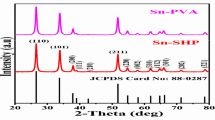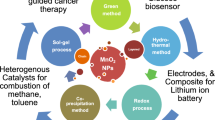Abstract
In the present study, nanoporous and nanotubular TiO2 structures were produced using the titanium anodization process and different parameters. The process was carried out using a solution of ammonium fluoride (0.04, 0.06 and 0.08 mol L−1), 10% (v/v) water and 90% (v/v) glycerin. The titanium plates were arranged at a 1 cm distance from each other at potentials of 15, 20 and 25 V and for different periods (15, 25 and 50 h). After anodization, the TiO2 nanostructures were calcinated at 450 °C for 30 min. The morphological and structural characterization obtained by scanning electronic microscopy and energy-dispersive X-ray spectroscopy shows the growth of different TiO2 nanostructures due to the variations in the experimental parameters. The X-ray diffraction measurements were used to calculate the grain size from the Scherrer equation. Cyclic voltammetry was used to observe the redox response and correlate the electro-chemical response with the experimental parameters for obtaining the TiO2 structures and their morphology. For the electrode produced during 50 h and at 25 V, an increase in the active surface area was observed, and the value of 0.68 cm2 for a geometric area of 0.24 cm2 was obtained, in addition to an increase in the electrochemical response.







Similar content being viewed by others
References
A.Y. Vakhrushev, T.B. Boitsova, TiO2 and TiO2/Ag nanofibers: template synthesis, structure, and photocatalytic properties. J. Porous Mater. 2021, 1–8 (2021)
C. Vanichvattanadecha, A. Jaroenworaluck, P. Henpraserttae, P. Wimuktiwan, P. Manpetch, W. Singhapong, Ordered mesoporous silica (SBA-16) supporting titania (TiO2) nanoparticles for photodegradation of paraquat (PQ) herbicide. J. Porous Mater. 28, 1137 (2021)
L. Gui, J. Peng, P. Li, R. Peng, P. Yu, Y. Luo et al., Electrochemical degradation of dye on TiO2 nanotube array constructed anode. Chemosphere 235, 1189–1196 (2019)
D.J. Ahirrao, H.M. Wilson, N. Jha, TiO2-nanoflowers as flexible electrode for high performance supercapacitor. Appl. Surf. Sci. 491, 765–778 (2019)
R. Deasa, S. Pearcea, K. Gossa, Q. Wanga, W. Chen, G.I.N. Waterhouse, Hierarchical Au/TiO2 nanoflower photocatalysts with outstanding performance for alcohol photoreforming under UV irradiation. Appl. Catal. A-Gen. 602, 117706 (2020)
F. Guo, X. Su, G. Hou, Z. Liu, Z. Mei, Fabrication of superhydrophobic TiO2 surface with cactus-like structure by a facile hydrothermal approach. Colloids and Surf. A 395, 70–74 (2012)
W. Wu, H. Rao, H. Feng, X. Guo, C. Su, D. Kuang, Morphology-controlled cactus-like branched anatase TiO2 arrays with high light-harvesting efficiency for dye-sensitized solar cells. J. of Power Sources 260, 6–11 (2014)
R.S. Dubey, S.R. Jadkar, A.B. Bhorde, Synthesis and characterization of various doped TiO2 nanocrystals for dye-sensitized solar cells. ACS Omega 6, 3470–3482 (2021)
X. Lin, M. Sun, B. Gao, W. Ding, Z. Zhang, S. Anandan, A. Umar, Hydrothermally regulating phase composition of TiO2 nanocrystals toward high photocatalytic activity. J. Alloys Compd. 850, 156653 (2021)
T. Guo, N.A.K. Oztug, P. Han, S.O. Ivanovski, K. Gulati, Old is gold: electrolyte aging influences the topography, chemistry, and bioactivity of anodized TiO2 nanopores. ACS Appl. Mater. Interf. 13, 7897–7912 (2021)
G. Strnad, Z. German-Sallo, L. Jakab-Farkas, C. Petrovan, D. Portan, Influence of electrical parameters on morphology of nanostructured TiO 2 layers developed by electrochemical anodization. MATEC Web of Conf. 112, 04021 (2017)
J. Qin, Z. Cao, H. Li, Z. Su, Formation of anodic TiO2 nanotube arrays with ultra-small pore size. Surf. Coat. Technol. 405, 126661 (2021)
S. Palmas, L. Mais, M. Mascia, A. Vacca, Trend in using TiO2 nanotubes as photoelectrodes in PEC processes for wastewater treatment. Curr Opin Electrochem 28, 100699 (2021)
S. Shirazi-Fard, F. Mohammadpour, A.R. Zolghadr, A. Klein, Encapsulation and release of doxorubicin from TiO2 nanotubes: experiment, density functional theory calculations, and molecular dynamics simulation. J. Phys. Chem. B 125, 5549 (2021)
R.A. Ocampo, F.E. Echeverría, Effect of the anodization parameters on TiO2 nanotubes characteristics produced in aqueous electrolytes with CMC. Appl. Surf. Sci. 469, 994–1006 (2019)
A. Haring, A. Morris, M. Hu, Controlling morphological parameters of anodized titania nanotubes for optimized solar energy applications. Materials 5, 1890–1909 (2012)
A.M. Laera, L. Mirenghi, G. Cassano, L. Capodieci, M.C. Ferrara, S. Mazzarelli, M. Schioppa, D. Dimaio, A. Rizzo, M. Penza, L. Tapfer, Synthesis of nanocrystalline ZnS/TiO2 films for enhanced NO2 gas sensing. Thin Solid Films 709, 138190 (2020)
S.K. Ponnaiah, P. Prakash, B. Vellaichamy, Ultrason. Sonochem. (2018). https://doi.org/10.1016/j.ultsonch.2019.104629
M.O. Taipina, M.G. de Mello, L. Tamborlin, K.D. Pereira, A.D. Luchessi, A.R. Cremasco, A novel Ag doping Ti alloys route: formation and antibacterial effect of the TiO2 nanotubes. Mater. Chem. Phys. 261, 124192 (2021)
K.H. Cheung, M.B. Pabbruwe, W.-F. Chen, P. Koshy, C.C. Sorrell, Thermodynamic and microstructural analyses of photocatalytic TiO2 from the anodization of biomedical-grade Ti6Al4V in phosphoric acid or sulfuric acid. Ceram. Int. 47, 1609–1624 (2021)
H. Buff, Ueber das electrische verhalten des aluminiums. Justus Liebigs Ann Chem 102, 265–284 (1857)
S. Wernick, The anodic oxidation of aluminium and its alloys. Trans IMF 9, 153–176 (1934)
M. Assefpour-Dezfuly, C. Vlachos, E. Andrews, Oxide morphology and adhesive bonding on titanium surface. J. Mater. Sci. 19, 3626–3639 (1984)
V. Zwilling, M. Aucouturier, E. Darque-Ceretti, Anodic oxidation of titanium and TA6V alloy in chromic media. An electrochemical approach. Electrochem. Acta 45, 921–929 (1999)
V. Zwilling, E. Darque-Ceretti, A. Boutry-Forveille, D. David, M.Y. Perrin, M. Aucouturier, Structure and physicochemistry of anodic oxide films on titanium and TA6V alloy. Surf. Interf. Anal. 27, 629–637 (1999)
D. Gong, C.A. Grimes, O.K. Varghese, W. Hu, R.S. Singh, Z. Chen, E.C. Dicke, Titanium oxide nanotube arrays prepared by anodic oxidation. J. Mater. Sci. Res. 16, 3331–3334 (2001)
C. Ruan, M. Paulose, O.K. Varghese, G.K. Mor, C.A. Grimes, Fabrication of highly ordered TiO2 nanotube arrays using an organic electrolyte. J. Phys. Chem. B 109, 15754–15759 (2005)
Z. Zhang, Q. Wang, H. Xu, W. Zhang, Q. Zhou, H. Zeng, J. Yang, J. Zhu, X. Zhu, TiO2 nanotube arrays with a volume expansion factor greater than 2.0: Evidence against the field-assisted ejection theory. Electrochem. commun. 114, 106717 (2020)
S. Garcia-Vergara, P. Skeldon, G. Thompson, H. Habazaki, A flow model of porous anodic film growth on aluminium. Electrochem. Acta 52, 681–687 (2006)
Ö.Ö. Çapraz, P. Shrotriya, P. Skeldon, G.E. Thompson, K.R. Hebert, Factors controlling stress generation during the initial growth of porous anodic aluminum oxide. Electrochem. Acta 159, 16–22 (2015)
W. Huang et al., Split TiO2 nanotubes− evidence of oxygen evolution during Ti anodization. Electrochem. commun. 106, 106532 (2019)
M. Yu, W. Huang, P. Li, H. Huang, K. Zhang, X. Zhu, Morphology evolution of TiO2 nanotubes with additional reducing agent: evidence of oxygen release. Electrochem. commun. 98, 28–32 (2019)
L.-L. Li, Y.-J. Chen, H.-P. Wu, N.S. Wang, E.W.-G. Diau, Detachment and transfer of ordered TiO 2 nanotube arrays for front-illuminated dye-sensitized solar cells. Energ. Environ. Sci. 4, 3420–3425 (2011)
G.G. Bessegato, F.F. Hudari, M.V.B. Zanoni, Self-doped TiO2 nanotube electrodes: a powerful tool as a sensor platform for electroanalytical applications. Electrochem. Acta 235, 527–533 (2017)
S.H. Kang, J.-Y. Kim, Y. Kim, H.S. Kim, Y.-E. Sung, Surf. modification of stretched TiO2 nanotubes for solid-state dye-sensitized solar cells. J. Phys. Chem. C 111, 9614–9623 (2007)
J. Macak, F. Schmidt-Stein, P. Schmuki, Efficient oxygen reduction on layers of ordered TiO2 nanotubes loaded with Au nanoparticles. Electrochem. commun. 9, 1783–1787 (2007)
F. Hilario, V. Roche, R.P. Nogueira, A.M.J. Junior, Influence of morphology and crystalline structure of TiO2 nanotubes on their electrochemical properties and apatite-forming ability. Electrochem. Acta 245, 337–349 (2017)
L. Xing, J. Jia, Y. Wang, B. Zhang, S. Dong, Pt modified TiO2 nanotubes electrode: preparation and electrocatalytic application for methanol oxidation. International J. Hydrog. Energy 35, 12169–12173 (2010)
L. Gan, Y. Wu, H. Song, C. Lu, S. Zhang, A. Li, Self-doped TiO2 nanotube arrays for electrochemical mineralization of phenols. Chemosp. 226, 329–339 (2019)
K.M. Chahrour, P.C. Ooi, A.M. Eid, A.A. Nazeer, M. Madkoure, C.F. Deea, M.F.M.R. Weea, A.A. Hamzah, Synergistic effect of bi-phased and self-doped Ti+ 3 on anodic TiO2 nanotubes photoelectrode for photoelectrochemical sensing. J. Alloy. Compd. 900, 163496 (2022)
H. Pan, M. Sun, X. Wang, M. Zhang, M. Murugananthan, Y. Zhang, A novel electric-assisted photocatalytic technique using self-doped TiO2 nanotube films. Appl. Catal. B 307, 121174 (2022)
R. Narayanan, T.-Y. Kwon, K.-H. Kim, TiO2 nanotubes from stirred glycerol/NH4F electrolyte: roughness, wetting behavior and adhesion for implant applications. Mater. Chem. Phys. 117, 460–464 (2009)
L. Qin, Q. Chen, R. Lan, R. Jiang, X. Quan, B. Xu, F. Zhang, Y. Jia, Effect of anodization parameters on morphology and photocatalysis properties of TiO2 nanotube arrays. J. Mater. Sci. Technol. 31, 1059–1064 (2015)
B. Munirathinam, H. Pydimukkala, N. Ramaswamy, L. Neelakantan, Influence of crystallite size and surf. morphology on electrochemical properties of annealed TiO2 nanotubes. Appl. Surf. Sci. 355, 1245–1253 (2015)
S. Nishanthi, E. Subramanian, B. Sundarakannan, D.P. Padiyan, An insight into the influence of morphology on the photoelectrochemical activity of TiO2 nanotube arrays. Sol. Energy Mater. Sol. Cells 132, 204–209 (2015)
P. Zhu, Y. Zhao, Cyclic voltammetry measurements of electroactive surf. area of porous nickel: peak current and peak charge methods and diffusion layer effect. Mater. Chem. Phys. 233, 60–67 (2019)
Acknowledgements
The authors gratefully acknowledge CAPES, CNPq and FAPEAM (project FAPEAM N. 0.62.01142/2019), UFAM for financial assistance provided for the present research work and the LPQI, DeGEO, LTMOE/CPAAF/INPA, OpTima, CMABio, Central Analítica labs at IFAM for assistance with equipment.
Author information
Authors and Affiliations
Contributions
VAM methodology, investigation, formal analysis, writing of original draft, visualization. FMP methodology, idea, investigation, review. NAB formal analysis, writing—review & editing, project administration.
Corresponding author
Ethics declarations
Competing interest
The authors declare that they have no known competing financial interests or personal relationships that could have appeared to influence the work reported in this paper.
Additional information
Publisher's Note
Springer Nature remains neutral with regard to jurisdictional claims in published maps and institutional affiliations.
Rights and permissions
Springer Nature or its licensor holds exclusive rights to this article under a publishing agreement with the author(s) or other rightsholder(s); author self-archiving of the accepted manuscript version of this article is solely governed by the terms of such publishing agreement and applicable law.
About this article
Cite this article
Maia, V.A., Paschoal, F.M. & Braga, N.A. TiO2 nanotubes produced by the anodization process under different parameters. J Porous Mater 29, 1981–1989 (2022). https://doi.org/10.1007/s10934-022-01307-0
Accepted:
Published:
Issue Date:
DOI: https://doi.org/10.1007/s10934-022-01307-0




